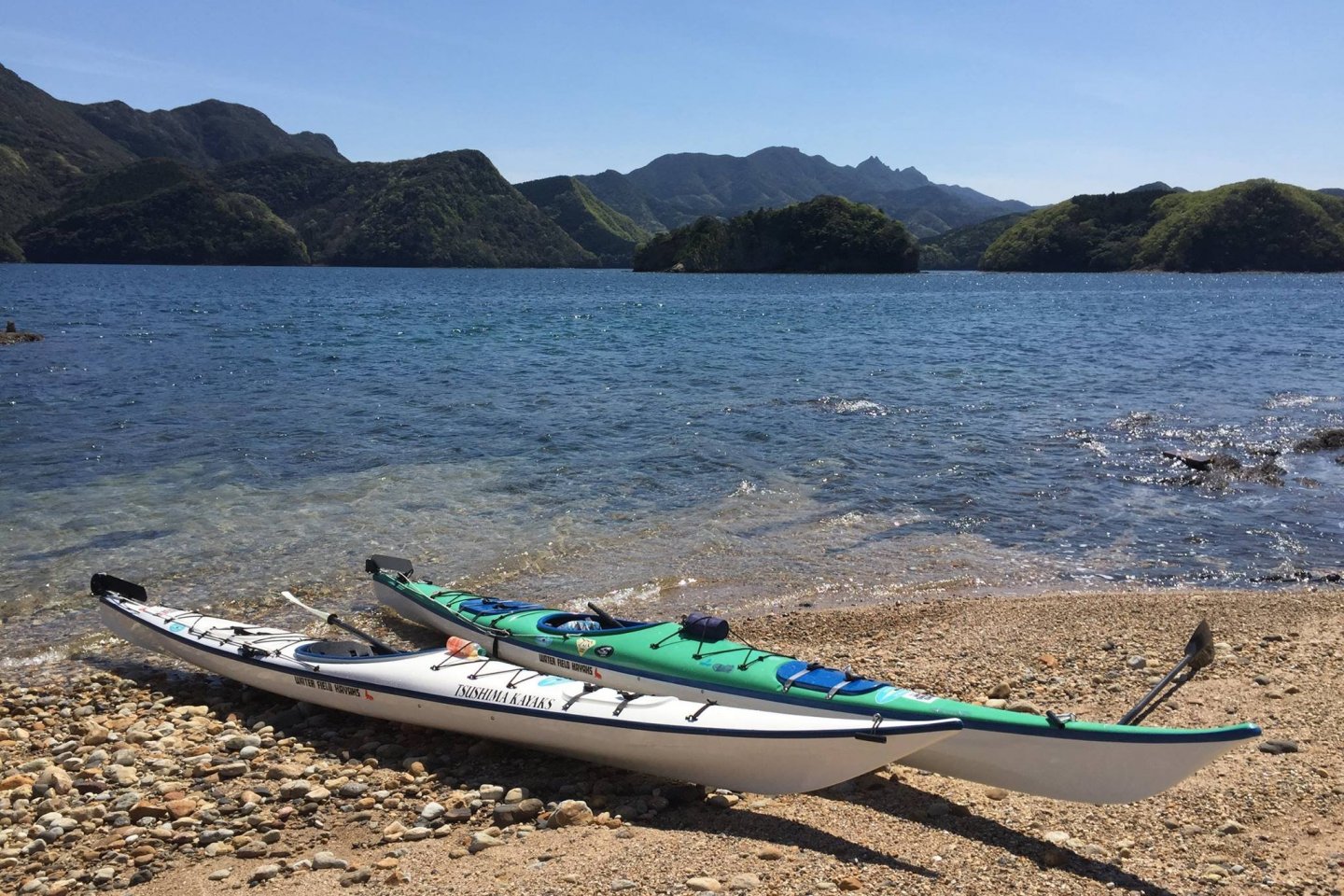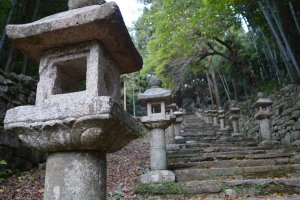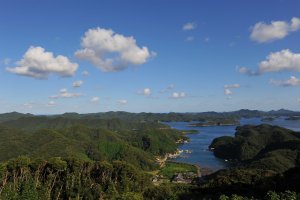Tsushima island is made up of one large island separated into two, North Tsushima (Kamino-shima 上島) and South Tsushima (Shimono-shima 下島) by canals. A natural preserve Tsushima is lushly covered over 89 percent with natural vegetation and numerous mountains. It is home to the famous Tsushima wildcat and one of the largest natural concentrations of Japanese honey bees. Tsushima is a place to embrace a traditional natural lifestyle. Many of its inhabitants still practice various agricultural techniques passed down through generations insuring a lasting relationship with the environment. The perfect place to visit if you value local, eco-friendly, outdoor oriented vacations.

Highlights at Tsushima
Tsushima is a mountainous island split in two by canals. A subtropical island full of forests, mountains, and surrounded by the sea. This island getaway is perfect for those that want a little of everything. Spend a day on the warm white sands of its multiple beaches, then cool off with a breezy hike up one of Tsushima’s many mountains. Enjoy its many agricultural delicacies such as the fermented Koukoimo (sweet potato treat), Iriyaki (chicken and fish hot pot), or fresh wild boar dishes just to name a few.
Below are some more gourmet highlights of Tsushima:
- Rokubee (ろくべえ): A beloved noodle dish of Nagasaki made not of rice or wheat but of sweet potatoes. The earthen colored noodles are bathed in a warm broth of soy sauce.
- Taishu Buckwheat (対州そば): Made into a delectable soba Taishu buckwheat should be tried from the local Tsushima restaurants throughout the island. A main agricultural feature of the island, Taishu buckwheat has its own unique flavor profile that will delight even the most seasoned soba eaters. It also makes a wonderful gift for your more culinary friends or family members, coming in a variety of packaged to use products.
- Tsushima Japanese Honey Bee’s Honey 和蜜(蜂洞): This amber colored treat comes from the now rare Japanese honey bee. Cultivated by farmers by traditional methods passed down the generations, this particular honey is perfect for gifts. Try it over mochi, fresh fruits of the island, or ice cream for a real treat.
Best Things to Do in Tsushima
Tsushima is a large island so it can be hard to know where to start. Between its vast number of beaches to lounge on and mountains to climb, Tsushima is also home to many fantastic historical and cultural treasure sights. Below are some recommendations to begin your journey or to pepper into your already best laid plans.
- Watazumi Shrine (和多都美神社): A shrine reminiscent of the old East Asian folk tales of the dragon kingdom, Watazumi Shrine, rests by the sea. Characterized by its line of five torii gates spanning from the ocean, two of which rise out of the ocean itself. The view changes with the ebb and flow of the ocean making this a spot to view with the change of the moon. It is also possible to rent and kayak to this shrine from the Shinwa-no-Sato Nature Park.
- Eboshidake (烏帽子岳展望台): A gorgeous 360-degree lookout point just above Aso Bay. A perfect place to view the mountains, the Korean Strait, and the tropical rias coast, with its myriad coves and islets.
- Kamitsushima Town (韓国展望所): A popular view point in Tsushima, Kamitsushima is only 50 km from South Korea. The area overlooks the ocean and gives a glorious view of Busan. This ‘border’ town incorporates traditional Korean architecture to lend a time warp style. The free-to-access Korean Viewpoint itself is modeled on a multi-purpose facility located inside Seoul’s Pagoda Park. The night view of Busan is not to be missed.
- Miuda Swimming Beach (三宇田浜海水浴場): Rated one of the top 100 beaches in Japan, Miuda Beach offers crystle-clear blue oceans, soft white sands, and sweeping mountain views. Located at the northern tip of Tsushima with easy access from Hitakatsu. Accommodations are made easy with a campground ready for only 1500 yen if you bring your own tent or 3600 yen if you need to rent one. If camping is not your thing, Miuda Pension is an easy walk from the beach with many room options.
- Tsushima Wildlife Conservation Center (対馬野生物保護センター): This Wildlife conservation center is home to many of the incredibly unique species home only to Tsushima. Come see a Tsushima leopard cat in person and learn all about the ecological uniqueness of this special island. Open from 10am–4:40pm daily. (last admittance at 4pm)
- Banshoin Temple (宗家菩提寺万松院): Built in 1615 by the Soh family is home to one of Japan’s three largest gravesites. This buddhist temple can be reached by taking the ancient stone steps through the solemn woods. Massive monuments sit at the top of the stairs to mark the graves of the once ruling family buried there. An awe-inspiring historical site to see.
- Tsutsuzaki (豆酘崎): A cape protruding from the southwestern coast of Tsushima overlooking the Tsushima Strait and the Korean Strait. Take a leisurely walk up the promenade built all the way out to the tip. Look out to a 180 degree view of the sea.
- Shiratake Mountain (白嶽原始林): A designated national natural monument due to its rare and important vegetation, this quartz-porphyry mountain reaches an altitude of 519 m. A perfect mountain hike for lovers of forests and a fantastic payoff. Once you reach the summit, marked by a massive white rock formation, be treated to a 360-degree view of the mountains like no other. If you are truly lucky you might spot the wild chrysanthemums that grow along the mountainside.
- Izuhara Port Festival (厳原港まつり(朝鮮通信使パレード): August 4th-5th 2018, Izuhara Port festival is a perfect day out for the whole family. Come enjoy one of the biggest festivals on the island full of Edo era style fun. Watch the Funaguro boat race. Reenactments of the Korean envoy’s arrival to the island in the Edo period are put on complete with several traditional performances. The whole joyous time is capped off with a fabulous fireworks display. Free entry.
- Sanzo ro Festival (サンゾーロー祭(亀ト神事): A small festival in Tutu Nishii hill, this little hidden gem performs a ritual not seen in other shrines. On January 3rd, marking the lunar new year, the temple priests dressed in traditional robes divine the future in a tortoise shell. This deviation is done only once a year and bode the future of this new year. After the ritual visitors can enjoy traditionally smoked fish and warm sake in a circle with everyone.
- Banshoin Temple Lantern Lighting Festival (万松院祭): Every October, come to the historical site and temple Banshoin, located in the Nagasaki prefecture, to enjoy the lighting of its 350 stone lanterns that line the steps up to the temple. A once a year occurrence that turns this peaceful forest path into one of stars.
- Watazumi Shrine Traditional Festival (l和多都美神社古式大祭(命婦の舞): One of the largest temple festivals on Tsushima, held every 1st August in the old calendar. This festival is made extra special as it is one of the few festivals where one can still see Kagura (traditional shrine maiden dances). These dances are said to be one of the oldest forms of Japanese entertainment and also act as a way of worship at the temple. The dances are a great way to experience Japanese historical culture and costume. After the somber dances the festival livens up with the shouts of boatmen in costume rowing out on the waters.
![Watazumi Shrine]()
Watazumi Shrine - Komoda Beach Shrine(小茂田浜神社大祭(鳴弦の儀): This festival commemorates the warriors who died in 1274 working to defend the area from invaders. Now you can walk down from the shrine to the beach along with armor clad warriors of the period. You will follow them to the “warrior matrix” on the beach where rituals and traditional bow shooting will commence. All this warrior spirit is uplifted by the thunder beat of drums and the warriors cries of ‘Oo’.

Connect with the Tsushima Locals with a Homestay
Tsushima offers a truly local experience through its Nohaku program. Nohaku is a homestay/farmstay experience that allows visitors to stay with local farmers, fishermen, forestry, and agricultural families in the Tsushima area. This is not simply a place to stay; it’s a way to live the local life.
Get hands on as you learn about the process from farm to table surrounded by family. Your island life becomes a time to learn about the lives of the agricultural community. Visitors will engage in the daily activities of the families, from fishing in the sea to farming the land and more. Enjoy the bounty of the land as you learn to make meals with your host family from seasonal vegetables and fresh fish.
Stay in traditional Japanese homes immersing you into the culture of Tsushima. Come meet your new Tsushima family and enjoy the natural life.

Local experiences also allow visitors to explore even more of their newfound island life. Delve deeper into the forests, mountains, oceans, and lives of Tsushima. Enjoy ocean fishing from shore or from a full size-fishing vessel. Meet the Japanese honeybees and their mushroom shaped homes. Pluck fruits from the trees or harvest a bounty of seasonal vegetables form the fields. Ferment and preserve the harvest or indulge your sweet tooth by making traditional sweets with the grandmas.
This is just to name a few of the engaging experiences waiting for you. There is an experience for everyone. Are you ready to change your perspective? Try a local experience and embrace the wisdom passed down from generation to generation while you learn skills to live a natural life.
How to book a Nohaku Stay on Tsushima
If you’re interested in exploring the local life , you can browse available homestays in Tsushima. Each home will have a bit about themselves, what areas you can see, what the family does, and lots of pictures. Stays start from 5,000 yen per person (without meals).

































